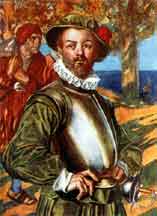
Known for being the first Englishman to circumvent the globe in 1580 after a harrowing voyage, Drake was a skillful navigator and also a pirate. He was knighted after returning home to England following the completion of his round-the-world feat. In the years afterward, Drake sailed to the Spanish Indies and America. As vice-admiral in 1588, he participated in tormenting the Spanish Armada. Death came to Drake while on an expedition to the West Indies..
Sir Francis Drake (c. 1540 – 1596) was an English sea captain, privateer, naval officer, and explorer. He is most famous for his circumnavigation of the globe between 1577 and 1580, which made him one of the most celebrated sailors of the Elizabethan era. Drake's exploits in the service of Queen Elizabeth I contributed to England's rise as a major maritime power and its rivalry with Spain during the late 16th century.
Drake was born in Tavistock, Devon, England, around 1540. He came from a relatively modest background, but his family had some connections to the sea, which helped him embark on a maritime career at a young age. He was apprenticed to a merchant who was involved in the coastal trade, and through this apprenticeship, Drake gained valuable experience in navigation and seamanship.
In the 1560s, Drake made his first significant voyages as a privateer, a legally sanctioned pirate, in the service of the English crown. He participated in several expeditions to the Caribbean, where he attacked Spanish ships and settlements, seizing valuable cargoes of gold, silver, and other goods. These raids were part of the broader conflict between England and Spain, which was fueled by religious differences and competition for colonial dominance.
Drake's most famous voyage began in 1577 when Queen Elizabeth I commissioned him to lead an expedition to explore the Pacific Ocean and disrupt Spanish interests in the Americas. He set sail from Plymouth with a fleet of five ships, including his flagship, the Golden Hind. The expedition faced numerous challenges, including treacherous weather, mutiny, and encounters with hostile indigenous peoples. Despite these difficulties, Drake successfully navigated the Strait of Magellan at the southern tip of South America, becoming the first Englishman to do so.
Once in the Pacific, Drake embarked on a series of daring raids along the west coast of the Americas, targeting Spanish ports and ships. One of his most famous exploits was the capture of the Spanish galleon Nuestra Señora de la Concepción, known as the "Cacafuego," which was carrying a vast treasure of silver and gold. This haul significantly enriched both Drake and the English crown.
After plundering his way up the western coast of South America, Drake continued his voyage across the Pacific Ocean, stopping in the Philippines and the Spice Islands before crossing the Indian Ocean and rounding the Cape of Good Hope at the southern tip of Africa. In September 1580, Drake returned to England, becoming the first Englishman to circumnavigate the globe. Queen Elizabeth I knighted him aboard the Golden Hind in 1581, recognizing his achievements and the wealth he had brought back to England.
Drake's exploits made him a hero in England but a hated figure in Spain, where he was labeled a pirate. His actions strained relations between the two countries and contributed to the outbreak of the Anglo-Spanish War in 1585. During this conflict, Drake played a key role in several naval campaigns, including the famous raid on the Spanish port of Cádiz in 1587, which disrupted Spain's preparations for the Armada.
In 1588, Drake served as vice admiral in the English fleet that defeated the Spanish Armada, a turning point in the war that established England's naval supremacy. Despite this victory, his later expeditions were less successful, and his influence waned.
Sir Francis Drake died of dysentery in January 1596 while on an expedition in the Caribbean. He was buried at sea off the coast of Portobelo, Panama. His legacy as one of England's greatest naval heroes endures, and he is remembered for his daring voyages, his role in expanding English influence overseas, and his contributions to the Elizabethan Golden Age.
 >
>